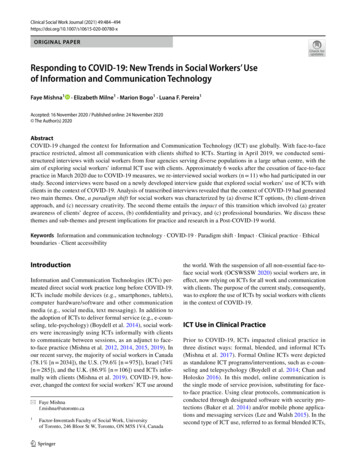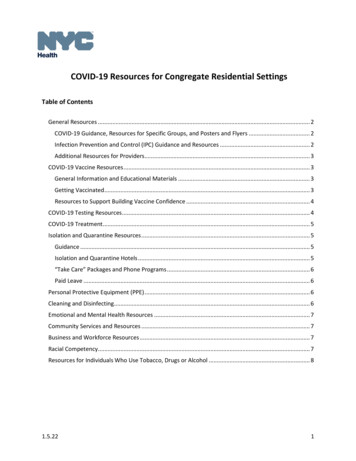
Transcription
Clinical Social Work Journal (2021) 80-xORIGINAL PAPERResponding to COVID‑19: New Trends in Social Workers’ Useof Information and Communication TechnologyFaye Mishna1· Elizabeth Milne1 · Marion Bogo1 · Luana F. Pereira1Accepted: 16 November 2020 / Published online: 24 November 2020 The Author(s) 2020AbstractCOVID-19 changed the context for Information and Communication Technology (ICT) use globally. With face-to-facepractice restricted, almost all communication with clients shifted to ICTs. Starting in April 2019, we conducted semistructured interviews with social workers from four agencies serving diverse populations in a large urban centre, with theaim of exploring social workers’ informal ICT use with clients. Approximately 6 weeks after the cessation of face-to-facepractice in March 2020 due to COVID-19 measures, we re-interviewed social workers (n 11) who had participated in ourstudy. Second interviews were based on a newly developed interview guide that explored social workers’ use of ICTs withclients in the context of COVID-19. Analysis of transcribed interviews revealed that the context of COVID-19 had generatedtwo main themes. One, a paradigm shift for social workers was characterized by (a) diverse ICT options, (b) client-drivenapproach, and (c) necessary creativity. The second theme entails the impact of this transition which involved (a) greaterawareness of clients’ degree of access, (b) confidentiality and privacy, and (c) professional boundaries. We discuss thesethemes and sub-themes and present implications for practice and research in a Post-COVID-19 world.Keywords Information and communication technology · COVID-19 · Paradigm shift · Impact · Clinical practice · Ethicalboundaries · Client accessibilityIntroductionInformation and Communication Technologies (ICTs) permeated direct social work practice long before COVID-19.ICTs include mobile devices (e.g., smartphones, tablets),computer hardware/software and other communicationmedia (e.g., social media, text messaging). In addition tothe adoption of ICTs to deliver formal service (e.g., e-counseling, tele-psychology) (Boydell et al. 2014), social workers were increasingly using ICTs informally with clientsto communicate between sessions, as an adjunct to faceto-face practice (Mishna et al. 2012, 2014, 2015, 2019). Inour recent survey, the majority of social workers in Canada(78.1% [n 2034]), the U.S. (79.6% [n 975]), Israel (74%[n 285]), and the U.K. (86.9% [n 106]) used ICTs informally with clients (Mishna et al. 2019). COVID-19, however, changed the context for social workers’ ICT use around* Faye Mishnaf.mishna@utoronto.ca1Factor‑Inwentash Faculty of Social Work, Universityof Toronto, 246 Bloor St W, Toronto, ON M5S 1V4, Canada13Vol:.(1234567890)the world. With the suspension of all non-essential face-toface social work (OCSWSSW 2020) social workers are, ineffect, now relying on ICTs for all work and communicationwith clients. The purpose of the current study, consequently,was to explore the use of ICTs by social workers with clientsin the context of COVID-19.ICT Use in Clinical PracticePrior to COVID-19, ICTs impacted clinical practice inthree distinct ways: formal, blended, and informal ICTs(Mishna et al. 2017). Formal Online ICTs were depictedas standalone ICT programs/interventions, such as e-counseling and telepsychology (Boydell et al. 2014; Chan andHolosko 2016). In this model, online communication isthe single mode of service provision, substituting for faceto-face practice. Using clear protocols, communication isconducted through designated software with security protections (Baker et al. 2014) and/or mobile phone applications and messaging services (Lee and Walsh 2015). In thesecond type of ICT use, referred to as formal blended ICTs,
Clinical Social Work Journal (2021) 49:484–494ICTs are integrated through a blending of online elementswith face-to-face practice (van de Wal et al. 2015). Onlineexercises, such as homework assignments and psycho-educational activities are implemented to replace some face-toface sessions (van der Vaart et al. 2014). Both online andface-to-face components are structured and monitored bya service provider (van de Wal et al. 2015). ICTs entereddirect practice through informal (sometimes unpredictable or unsanctioned) use by social work practitioners asan adjunct to traditional face-to-face service. The primary(and formal) modality is face-to-face (Mishna et al. 2012,2014). Informal ICT use occurs in conjunction with face-toface practice through email, texting, or social media/socialnetworking, and can be asynchronous or synchronous. Notmeant to substitute for face-to-face practice, rather, informalICT use typically serves as an unplanned added component.Reasons for informal ICT use range from practical purposes(e.g., scheduling) to complex discussions that are central totreatment goals (e.g., reporting intense distress).COVID‑19: ICT Use in Clinical PracticeWithout preparation, the COVID-19 pandemic and associated risk of contamination brought the need to practice physical distancing around the globe, which required significantchanges in the way most services operate (Galea et al. 2020).On March 24, 2020, Ontario Canada ordered the mandatoryclosure of all non-essential workplaces to fight the spread ofCOVID-19 (Office of the Premier 2020). In response to therestrictions to face-to-face practice, governments, regulatory bodies and licensing boards in the United States andCanada temporarily relaxed restrictions surrounding ICT useand even encouraged mental health professionals to use newtechnologies with their clients (Wallace et al. 2020). Forexample, the Ontario College of Social Workers and SocialService Workers (OCSWSSW 2020) recommended thatmembers consider providing services through any electronicdevice (e.g., a computer, tablet, smartphone, landline) orformat (e.g., Internet, email, social media, chat, text, video).Due to the rapid onset of COVID-19 restrictions, theshift to electronic service provision happened very quickly(Doorn et al. 2020; Olwill et al. 2020; Razai et al. 2020;Walter-McCabe 2020). With virtually no notice, socialworkers were required to transition to using ICTs to replaceface-to-face services and all communication with clients.Without proper training or support on providing this treatment (Doorn et al. 2020), social service providers are leftwith many questions about how they can appropriately usetechnology to bridge the gap caused by COVID-19 (Wrightand Caudill 2020). Nevertheless, social service providershave demonstrated a great deal of creativity in their use oftechnology to deliver services and maintain relationships485with clients, and to provide continuity of care, necessaryemotional support and communication (Boahen 2020; Farkas and Romaniuk 2020; Galea et al. 2020).With this new context of COVID-19, the previous distinctions between informal and formal ICT communicationhave come into question. The traditional conceptualizationof informal ICT use, as an adjunct to face-to-face service,no longer exists due to the cessation of face-to-face practice.Moreover, while governments, agencies, regulatory bodies,and licensing boards have asked social workers to providetheir formal services remotely, this ICT use does not directlyfit within the traditional definition of “formal ICTs”. Thenew ICT use encompasses a significant range of securityprotection and a lack of clear protocols.The Current StudyThe current study is an amendment of a qualitative study initiated prior to the COVID-19 pandemic. The original studyis the second of two sequential phases in a mixed-methodsstudy. The first phase entailed an online survey administeredto social workers in Canada, the United States, Israel, andthe United Kingdom, comprising questions related to thefrequency, nature and scope of informal use of ICTs in theirtraditional face-to-face practice. Beginning in April 2019,the second phase consisted of semi-structured interviewswith social workers and clients. The phase one survey datainformed the interview guide. The original guiding researchquestions examined the ways social workers used informalICTs and the impact of this use on face-to-face practice.The onset of COVID-19 and the cessation of face-to-facepractice, however, dramatically changed the context of socialworkers’ ICT use. With social workers forced to quicklytransition to using ICTs for all work with clients, we recognized the need to explore social workers’ ICT use withclients in the context of COVID-19. Accordingly, we developed an additional interview guide to be utilized in the current study. The amended research questions investigate theways social workers used ICTs during this global pandemicand the impact of this use on practice.MethodsThe original qualitative study was amended and receivedapproval on April 21, 2020 from the University of TorontoHealth Sciences Research Ethics Board, to investigatesocial workers’ ICT use with clients in the context ofCOVID-19. Approximately 6 weeks after the cessation13
486of face-to-face practice, we re-interviewed social workers (n 11) who had participated in the study before theiragencies implemented remote work. The second interviewswere semi-structured phone interviews approximately 30to 45 min in length.Recruitment and SampleRecruitment for phase two of the study began in April2019. Social work practitioners were recruited from fouragencies across the Greater Toronto Area. These sites wereselected to maximize variability in the sample as the participating agencies serve diverse populations of youth andadults with a range of individual, family and group-levelservices. To be eligible, service providers were requiredto: (1) be registered with the Ontario College of SocialWorkers and Social Service Workers or have a BSW orMSW; and (2) be involved in direct face-to-face practice.For initial participant recruitment, agency administrators sent email invitations and flyers to introduce thestudy to individuals and provide the Research Coordinator’s contact information. In addition, research assistantsset up recruitment tables in agency foyers and attendedstaff meetings to publicize the study. Twelve social workpractitioners agreed to participate. Informed consent wasobtained prior to either their in person or phone interviews. Participants were compensated with a gift card.Recruitment for the additional interviews during COVID19 entailed the Research Coordinator sending email invitations and reminders to the social workers who had participated in the original interviews (n 12). Participants didnot receive additional compensation.The data corpus, i.e., all data collected for this study,includes a total of 52 interviews with staff (n 31) andclients (n 21) (Braun and Clarke 2006). As data collection is ongoing, these numbers are expected to grow.The data set, i.e., data from the corpus being used for thisanalysis, comprises 11 social workers (9 females, 1 male,1 Non-Binary/Gender ender) who agreed to participatein a phone interview during COVID-19. This data set wasidentified with a particular analytic interest: social workersaffected by COVID-19 measures. The participants wereconsequently conducting most of their work remotely.Participants were between 27 and 49 years, with anaverage of 31 years. Most participants had been in practice for 1–5 years (n 5) or 6–10 years (n 4), with oneparticipant in practice for under 1 year, and one for over20 years. Participants worked in diverse practice areasincluding mental health, developmental services, childwelfare, violence against women, seniors, children, youthand families, case management, and 2SLGBTQ therapy.13Clinical Social Work Journal (2021) 49:484–494Data Collection and AnalysisIndividual interviews were conducted following the newsemi-structured interview guides. Interview guides forthe additional interviews explored the changes due toCOVID-19 that had taken place with regards to socialworkers’ use of ICTs with clients, as well as opportunities and challenges introduced by these changes. Trainedresearch assistants conducted the approximately 30–45min telephone interviews. With participant consent, theinterviews were audio-recorded using ID numbers, andtranscribed verbatim by a transcription service to allowfor thematic analysis of content (Braun and Clarke 2006).A list of matching ID numbers and names was compiled toensure anonymity in the audio recording and transcripts.NVivo qualitative software was used to organize the data.Research team members interpreted the data usingBraun and Clarke’s recommended procedure for thematicanalysis (2006). To provide an overall description of socialworkers’ use of ICTs during COVID-19, we decided toprovide a rich thematic description of the entire data set,meaning that the themes identified, coded, and analysedwould reflect the content of the entire data set. Furthermore, we chose to conduct inductive thematic analysis, byidentifying themes that were most strongly linked to thedata themselves. The themes were chosen based on thefrequency with which they appeared across the data set,rather than the relevance to the researchers’ theoreticalinterests. Finally, we chose to frame the thematic analysis using a realist framework by deriving meaning in astraightforward way, whereby language was assumed toreflect and enable one to articulate motivations, experience and meaning. Thematic analysis, thus, used a semantic approach, in which themes were identified within theexplicit meanings of the data, i.e., what a participant said(Braun and Clarke 2006).Researchers, then, followed Braun and Clarke’s (2006)six step approach to engaging with text-based data, andbegan the coding process by reading and re-reading theinterview transcripts to become familiar with the data.Next, using NVivo, researchers coded interesting featuresof the data in a systematic fashion across the data set, andcollated codes into potential themes. During a series ofmeetings with the Principal Investigator, the research teamreviewed the themes and began defining and naming thethemes. An initial thematic map was created, which wasfurther refined and reworked until the candidate themeswere considered to adequately capture the contours ofthe coded data. Following the semantic approach, the initial description of the patterns in the semantic content ofthe data was followed by an interpretation of the broadermeanings and implications (Braun and Clarke 2006).
Clinical Social Work Journal (2021) 49:484–494FindingsAnalysis revealed two main themes, with three sub-themeseach. The first theme, a paradigm shift in ICT use, encompassed three sub-themes, (a) diverse ICT options, (b) clientdriven approach, and (c) necessary creativity. The secondtheme, impact, encompassed three interconnected subthemes, (a) greater awareness of clients’ degree of access (b)confidentiality and privacy, and (c) professional boundaries.Theme One: A Paradigm Shift in ICT UseAll the participants’ descriptions of their changes to servicedelivery due to COVID-19 physical distancing measuresindicated a paradigm shift in social workers’ ICT use. Withthe absence of face-to-face treatment, social workers andagencies introduced diverse ICT options, and adapted theirICT use to fit the needs of clients and creatively maintainthe therapeutic relationship and process.Sub‑theme A: Diverse ICT OptionsThe social workers reported that their agencies’ responses toCOVID-19 involved a substantial expansion of ICT optionswhich social workers could use with clients. The participantsall discussed their agencies’ new authorization to use eithertheir work or personal cellphones as a method of providingphone counselling, in addition to several video-conferencing platforms through which to communicate with clients.Most agencies supported Zoom, FaceTime and/or WhatsApp video calling as platforms to provide formal sessions.Participants from only one agency reported being restrictedto a single video-conferencing platform, OnCall, which isboth HIPAA (Health Insurance Portability and Accountability Act) and PHIPA (Personal Health Information Protection Act) compliant. Most participants further reportedtheir agencies’ new authorization of SMS, text messagingand/or WhatsApp messaging with clients, using either theirwork or personal cellphones. Participants from one agencyreported their agency’s authorization of new uses of theirexisting email to communicate client care plans and safetyplans, and as on participant explained, “whereas one mightconsider email an [informal] ICT, we have found a wayto include email as part of the therapeutic communication We formalized it.”In addition to the new dependence on ICTs for communication with clients during COVID-19 and in response totheir agencies’ new authorization of ICT use, all participantsreported adopting new ICT practices in their work with clients. Despite approval to use video-conferencing platforms,many reported introducing phone calls for many of theirformal sessions with clients. Several participants, however,recounted using video-conferencing platforms, specifically487Zoom or OnCall, as their main platform, whereas othersused email and text messaging as their formal treatment.According to one participant, “if [text-messaging or email]are the only form of communication we can do in thatmoment, then I definitely provide that emotion coachingpiece. So, validation, emotional support, practical support,as well as if they need behavioral coaching, I would providethat over email.”Most participants relayed that they introduced new uses ofICTs with clients. A few social workers reported now usingWhatsApp and text messaging to fulfill practical needs,which they previously had limited to face-to-face interactions, such as receiving documents from clients and sending resources to clients. One participant clarified, “before[COVID-19], they had to come to take the letter, come allthe way to my office and let me see it. With text messages,they can just take me a picture and then I can do the translation for them.” Another participant stated, “I think a lot ofthe time what I originally used to arrange was an in-personsession and then a follow-up phone call. Now that I’m doinga phone call session, I’m often doing a follow-up text, just togive that kind of space to let clients process and check in asthey need.” In this instance, the participant’s original use ofthe phone call as an informal ICT communication methodbecame their formal method of treatment during COVID-19,and text messaging between phone call sessions became thenew informal ICT. These examples are illustrative of a paradigm shift in ICT use, as they demonstrate social workers’introduction of new ICT uses, and devices, that go beyondtraditional definitions of “formal” vs. “informal” ICTs.Sub‑theme B: Client‑Driven ApproachA key component of the paradigm shift in ICT Use during COVID-19 consistently mentioned by social work participants was centering their practice based on the needsand preferences of clients. Many social workers describedtheir agencies’ newfound flexibility towards staff’s selectionof ICTs. For example, one participant explained, “they’vejust said, you know, as long as the person’s comfortableand you’re comfortable with them seeing where you liveor whatever background you have then go ahead.” Withrespect to their agency’s preference for a particular type ofICT, another participant similarly observed, “they’ve sortof left it to our discretion. They’ve opened the conversationsaying that no matter how we want to approach it they’reopen to talking about it.” This flexibility was combined withencouragement of staff to choose ICTs based on the clients’preferences. As one participant claimed, “as long as the client initiates and they give the consent of using that platform,well, [the social workers] still have to do it.” Another participant relayed, “we try to be client-centred, so whatevermakes sense for the client in that moment. We are providing13
488that option for each family. Comfort levels might be differentfor each family, so we have questions we ask families beforestarting the videoconferencing.”Participants reflected this flexibility and client-drivenapproach. The majority described choosing ICTs based onthe client preferences. For example, according to one participant, “I just do whatever works for the foster parents, Iuse WhatsApp, Zoom, FaceTime. Then with my teens, theydon’t often want a video chat, so I talk to them on the phoneor I text with them.” Another participant observed, “somefamilies, some weeks are not really liking the whole phone,video piece, so it allows them to have a different form oftherapy or guidance or support in times of need. Havingthose platforms as options has really allowed me to meetthe families where they’re at and what they’re needing atthat moment.” Participants demonstrated an awareness andflexibility based on the unique circumstances and needs ofeach client. As one social worker reflected, “I’m choosingto use email because it gives them more flexibility on whenthey respond. My families are home now with their kidswhich makes it harder for them to spend like 20 min talkingto me on the phone because their kids are needing them. So,text and email are sometimes better.” Another participantsimilarly stated: “some parents have expressed that, becausethey have younger children with high needs, being able to setup a tablet or a laptop and sit in front of it for an hour mightbe challenging. Having the phone, being able to talk to meand move around to do things to keep their kids’ emotionsmanaged and keep them busy has been helpful. Yeah, we’vebeen really leaving it up to the client.”Sub‑theme C: Necessary CreativityThe third sub-theme within the theme of a paradigm shiftin ICT use was the need for social workers to use creativestrategies to remotely maintain their therapeutic relationships with clients. Many of the participating social workersreported finding innovative ways to sustain their connection with clients during these uncertain times. For example,one social worker observed, “at the beginning, I can seemy contact drop, just very brief, much shorter interviews.”They explained that they then found new ways to connectwith clients by texting or emailing them various activitiesor websites. This social worker further specified, “there wasone website, they are doing a 13-day challenge using arts,and then I can do it together with the client, and we don’tneed to talk that much, but somehow, we can stay connectedin that way.”Several participants described scenarios in which theyexhibited creativity to maintain the therapeutic process despitethe challenges of remote work. for example, a social workerdepicted having trouble connecting with a client who wasstruggling to get out of bed due to depression. Remembering13Clinical Social Work Journal (2021) 49:484–494that this client was talented and enjoyed playing piano, thesocial worker suggested that the client play a song on the pianofor the social worker over FaceTime. The social worker proposed to the client: “don’t talk and just play a song for me, notevery day, but every other day, and then just three minutes,we can do it on Facetime, and after the three minutes we’regone, we’re done, don’t say anything, just connect.” The clientagreed and according to the social worker, told them that theirregular musical FaceTime sessions gave the client “a reason toget out of bed, brush their teeth and wash their hair.”A second participant who identified as an 2SLGBT therapist observed that a few of their clients who were transturned their camera off during some video sessions out of adesire not to be seen and not to see their own self-view onthe screen. The social worker supported these clients in turning their cameras off during sessions. To ensure that nothing was lost in the session, the social worker explained thatthey were “by default, slowing down the session, checkingin more often, using not necessarily different language,but being very intentional about what language [they] use tocheck in.” The social worker further added that in responseto no longer being able to read visual cues, such as their client’s body language or facial expressions, the social workerrelied on their somatic training to check in with the client’ssensations, behaviors, imagery and meaning-making.A third instance entailed a social worker who discussedthe ways in which using ICTs as their formal treatmentnecessitated that they consider new ways of applying theirclinical skills. They explained that in video-conferencingsessions, there is “a different type of intimacy” because oftheir ability to see each other’s homes. They specified theconsiderations they accordingly made: “someone might bemore willing to share things over the computer that theywouldn’t necessarily be willing to share in-person.” The participants observed that while in a face-to-face session, theywould be more confident about following the client’s lead,with web-based technology, they were mindful of the possible disinhibition effect of the internet (Suler 2004). Anotherparticipant said, “I realize I have to slow down and makesure to check in with them as to whether that is somethingthat they, in fact, want to explore at this point.”Theme Two: ImpactIn addition to describing the paradigm shift in the use ofICT during the COVID-19 context, social workers relayedthe impact of this transition.Sub‑theme A: Greater Awareness of Clients’ Degreeof AccessMost participants described the ways in which the transitionto remote work during COVID-19 created a shift in client
Clinical Social Work Journal (2021) 49:484–494access to services. While some clients experienced enhancedaccess to services, others had less. This is illustrated by thefollowing quote: “if you only ever offer services in one way,it would be inaccessible to someone. While switching toweb-based is inconvenient for some, it’s incredibly convenient for others. We’re reaching slightly different clientpopulations.” Several participants mentioned that clientswho experienced anxiety were more able to access servicesduring COVID-19. According to one participant, “some clients who previously had anxiety about going out are findingthis actually, right now, is at least helping their anxiety to beable to stay at home and talk about what’s going on.” Participants noted greater access for clients in remote locations, aswell as for clients who experience barriers to service, suchas transportation issues. A social worker in an Indigenousagency explained that before COVID-19 their cultural programming was not accessible to their youth in foster carebecause they lived outside of the city. “When it becamevirtual,” however, they “saw how many of our kids in carewere attending over Zoom,” and consequently “always madea separate one for our kids in care.” Finally, participantsdescribed the ways in which the transition to online services increased access for clients, particularly youth, whorely on others, such as their parents or guardians, to attendtreatment. As one participant stated, “One client who I washaving trouble scheduling with because their parents didn’twant to bring them, or they had to navigate their parents’schedule, well, now, all of a sudden, it’s easier because theycan just open their iPad and then, click, there I am.”Most of the social workers recounted gaining awarenessof the many ways in which this new reliance on ICTs tocommunicate with clients underscored some clients’ lackof access. The majority discussed difficulties contacting client based on the inequity of client resources, due to lack ofaccess to Internet or smartphones. For instance, one participant observed, “the ones who don’t have Internet are definitely feeling a lot more isolated. They’re not able to participate in a lot of the online hangouts happening.” According toanother participant, “I think one piece that can be challenging is being able to send resources, or anything to follow-upafter sessions. Some clients don’t necessarily have internet athome. I have a few clients who only have it on their phone,so to be able to read or access a resource that way isn’t asuseful as at the end of a session when you’re handing them aresource.” Of note, participants from two agencies reportedthat their agencies delivered cellphones to clients who didnot have access to phones, each explaining that the agencywas temporarily paying for the text and call capabilities.Many participants commented on encountering challenges connecting with clients equally due to clients’ lackof computer literacy skills or comfort level with technology. One participant mentioned, “the families who are489more computer literate definitely have an advantage interms of being able to access resources and things likethat because some things are really hard to explain overthe phone and can’t be explained over text.” Another participant stated, “I work with seniors and not to say thatseniors are not tech savvy, but the ones I’m connected withare for the most part choosing to just use phone or aren’tvery comfortable with the Zoom technology.”Many participants identified the difficulty contactingclients due to a client’s lack of privacy, especially thoseliving with perpetrators of abuse or with family memberswho do not support their therapy. One participant stated,“some clients, for sure, there’s an inability to find a privatespace, as well, at home because of being at home withfamily. We deal with some cases of elder abuse, in whichcase clients live with potentially the abuser. In those cases,it can be really challenging to support clients in the sameway as we would have if they were able to come into theoffice to talk about what’s actually going on.” Anotherparticipant explained
computer hardware/software and other communication media (e.g., social media, text messaging). In addition to the adoption of ICTs to deliver formal service (e.g., e-coun-seling, tele-psychology) (Boydell et al. 2014), social work-ers were increasingly using ICTs informally with clients to communicate between sessions, as an adjunct to face-











